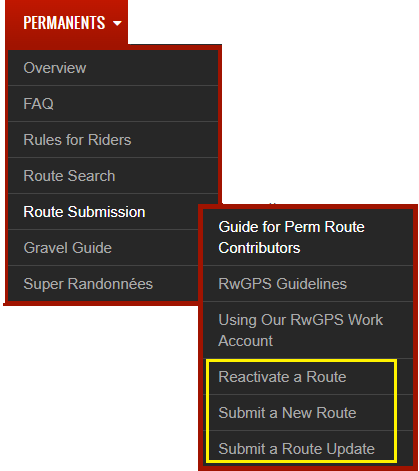Introduction
A Permanent is like a brevet, but can be ridden on a date of the rider's choosing. Permanent rides in the USA are sanctioned and validated by Randonneurs USA. RUSA members who register to ride a Permanent route must follow the Rules for Permanent Riders. Like brevets, Permanents are not casual affairs. Any RUSA member may contribute routes to the RUSA Permanents library, so that RUSA members may ride them. Randonneurs USA thanks all volunteers who contribute to the organization of these rides, and as a consequence to the development of long distance cycling in the USA.
Contributing a Permanent Route
Members may contribute a new route to the RUSA Permanents Library, or an existing inactive route, or ask that an active route be updated. Here's what needs to be submitted:
- a filled-in route contribution questionnaire ... for submitting a new route, reactivating a route, or submitting a route update. (See Resources below.)
- a RideWithGPS route that contains all the info needed to ride the route - including checkpoints, services, advisories, and tips - as detailed in the RUSA RideWithGPS Guidelines for Perms.
You will need access to a RideWithGPS Premium account in order to create or edit the "complete" route described above. If you do not have personal access to a Premium account, you may use the RUSA Club Work Account, described here.
When you submit a route, it will be reviewed by the Permanents Committee, who may ask you to fix certain issues. The committee will activate or update the route when it's ready, and members will then be able to register to ride it.
Routes
A Permanent may be any distance of 200km or more. A Permanent Populaire may be from 100-199km.
Changes can be submitted by the original contributor or someone else. The Permanents Team will review any suggested changes with the original contributor.
The route may start and finish in the same place, or finish in a different location (point-to-point), and follow any number of shapes in between, but may not contain repeated loops.
Permanent routes are "free routes." That means that riders may take any safe and legal route between checkpoints, (or follow the route you submitted). That "default" route you submit determines the official distance credited for riding the Permanent and amount of unpaved distance credited. Therefore, it should be close in distance to the shortest safe and legal routing between checkpoints.
Checkpoints
Similar guidelines apply for checkpoints on Permanents as on brevets. Checkpoints should be more or less regularly spaced between the start and finish. Typically, checkpoints should be about 50-100 km (30-60 miles) apart depending on total route distance. Additional checkpoints should be located at any point along the route where a shortcut might be taken. It can be beneficial to locate checkpoints with an eye for allowing more free-routing options, while preserving distance integrity for the route as a whole. If the Permanents Team sees that significant shortcuts are possible, they will ask you to add or move checkpoints.
Intermediate checkpoints have no opening and closing times. There is only an overall time limit for completing the ride. Unlike cues for intermediate checkpoints on brevets, populaires, and grand randonnées, opening and closing times for perm checkpoints are not shown. This is in part because of the free-route nature of perms. Overall time allowed is also not shown. The time limit - including allowance for unpaved distance - can be found on the details page for each perm route.
Checkpoint Proofs of Passage
Proof of passage can be (a) a receipt from an establishment or clerk’s annotation of time of passage on a brevet card, (b) receipt from an automated device showing the time of passage (such as an ATM), (c) timestamped photo identifying the checkpoint location, or (d) a GPS track passing through the checkpoint location. The contributor can provide options for (a), (b) and (c) on the cue sheet, e.g., a specific establishment for receipt, or "any establishment at this location," location of ATM or other automated device at a checkpoint locus, and/or identifying subjects for a photo, such as an establishment, street sign, historical plaque, etc. This info goes in the cue for each checkpoint.
Availability
Time periods during which this route is ridable or recommended for riding - e.g. 12 months, March through October - can be supplied on the perm route application. Restrictions may reflect extreme weather, seasonal road closures (e.g., because of no winter maintenance), high-season traffic conditions, etc. There is no enforcement of these restrictions in registering to ride a permanent, but riders are expected either to plan in accord with available time periods, or do some research to find out whether riding in a restricted period is feasible or safe. Therefore, "availability" is useful data to potential riders.
Cue Sheet Checklist
The following items need to be included in cues in the RideWithGPS cue sheet submitted for a route:
- start checkpoint, finish checkpoint, and each intermediate checkpoint,
- proof of passage details for each checkpoint,
- street address or other unique location information in the cues for checkpoints (to be included in the cues for checkpoints),
- warnings, cautions, and advisories - e.g., traffic, railroad crossings
- possible delays due to ferries, trains, drawbridges, etc.,
- services at particular points, or lack of services over a given stretch.
Resources
- RUSA RideWithGPS Guidelines for Perms
- Using our RideWithGPS Work Account
- Route Submission Forms - highlighted in yellow rectangle below
These resources and more are available under the PERMANENTS dropdown on the RUSA website.

